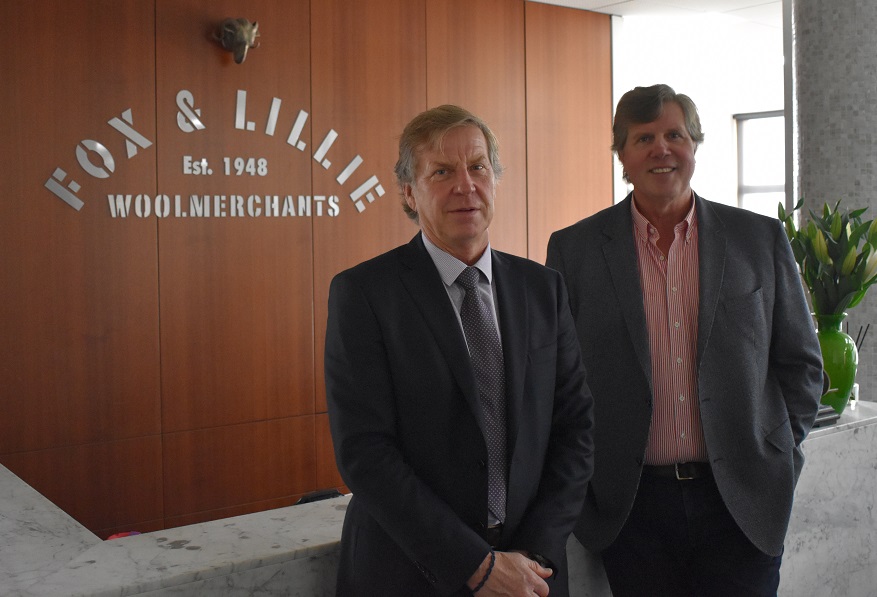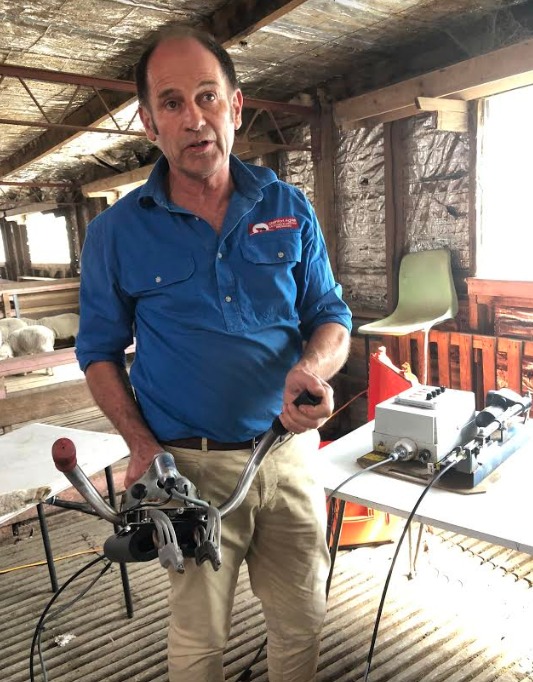
Fox & Lillie managing directors James and Jonathan Lillie.
THE Australian Wool Exchange’s inclusion of sheep freeze branding within its non-mulesed category on the National Wool Declaration is unlikely to be reviewed until next year, despite exporter Fox & Lillie joining calls for a re-think.
After three rounds of industry consultation, AWEX in March this year upheld its former position to classify the liquid nitrogen-based freeze branding process as ‘non-mulesed’ on its National Wool Declaration.
The decision angered non-mulesed wool growers and was opposed by some integrity schemes and animal welfare bodies, but was welcomed by Australia’s peak grower body WoolProducers Australia and growers seeking an alternative to surgical mulesing.
This week managing director of major Australian exporter Fox & Lillie, Jonathan Lillie, released an opinion piece, stating that if AWEX did not wish to diminish its position as a trusted independent and transparent service provider for the Australian wool industry, “it should correct this flawed decision on the NWD.”
AWEX chief executive officer Mark Graves said in March that a further review of the NWD with respect to mulesing status, and identification of wool from sheep processed with freeze branding, would take place within 12 months, or when the results of scheduled trials with clear animal welfare outcomes were available, “whichever comes first.” He told Sheep Central this week that this position had not changed.
Sheep freeze branding is being marketed by AgVet Innovations partners, developer John Steinfort and wool broker AWN. AWN managing director John Colley said the protocols and terms of reference for the University of Melbourne freeze branding research have been signed off on and have gone before the university’s animal ethics committee.
“So we are at contract with them to have it done and the trials will start in July/August with interim reports available before Christmas and a final report just after Christmas.”
Mr Lillie said although 80 percent of the company’s turnover is wool from mulesed sheep, it is also marketing non-mulesed wool from a group of growers in a Responsible Wool Standard program.
“New ideas will come along, but the bottomline is intrusive operations on a sheep have to be declared on the NWD, it has to be given a definition and the market will make up its own mind.”
Mr Lillie believed non-mulesed wool production was certainly a growth area for the industry, but the reputation of Australian wool would continue to suffer while there was a lack of transparency on the NWD.
“Whatever we do, we’ve got to have transparency.
“Non-mulesed growers are being demeaned by this decision of AWEX.”
He did not believe, even if the pain trial results were favourable, that the market would accept the freeze branding process as equivalent to not mulesing, because it was an intrusive procedure on the breech of a sheep.
“I don’t believe that will happen, the market has made up its own mind.”
Fox & Lillie’s stance on the issue has been supported by specialist Australian non-mulesed wool supplier New Merino, with owner Peter Vandeleur stating on his website that freeze branding is different to surgical mulesing it is still a form of breech modification and is not currently accepted by animal welfare organisations, animal welfare standards organisations (eg Textile Exchange) and many brands around the world.
“To be completely transparent, the liquid nitrogen system should have its own classification so that consumers, brands and processors can reach their own conclusions as to its acceptability,” he said.
Freeze branding research will mimic on-farm best practice

Sheep freeze branding developer Dr John Steinfort.
Freeze branding developer John Steinfort said it was hoped to make some initial reports on the university research trials before December this year.
He said the research was a comparative study on lambs at marking of sheep freeze branding, with lamb marking only (hot knife) and mulesing. The freeze branded and mulesed lambs will also have their tails docked with a hot knife. Some mulesed animals will get Tri-Solfen and meloxicam, and other will be treated with meloxicam only.
“All groups would be receiving a meloxicam injection which has both anti-inflammatory and an analgesic components that last for 72 hours.
“The study will go from marking to weaning, and over that period we are recording growth rates and skin repair parameters, and behavioural parameters over a defined period, to get an understanding of how the animal is reacting,” he said.
“It is assessing the impact on the animal.”
Dr Steinfort said the study will mimic what happens on Australian farms today.
“We want the best animal welfare benefits for the animal for the whole of life, not just around lamb marking.
“We don’t want to see them with excess wrinkles and getting cut every time they get crutched and shorn,” he said.
“My personal aim has been for the animal to take up a process that is not mulesing an animals, that is not cutting an animal open, which is what the majority of the world has been really upset about, to a process that is much more humane, and our initial growth rate trials have shown that.
“What we are on about is just showing evidence of best practice and best practice using pain relief.”
Big issue of transparency with the National Wool Declaration
By Jonathan Lillie
The wool industry is once again shooting itself in the foot by allowing the “cryogenic breech freezing” process to be reported on the National Wool Declaration (NWD) as non-mulesed (NM) wool, losing the opportunity to promote complete transparency in the Australian wool industry.
To be clear, Fox & Lillie is not opposed to any progressive and economically viable process in sheep husbandry that adheres to 21st century animal welfare standards, but any new intrusive process must include a clear definition and description to allow the market to make up its own mind about whether any new procedure or process adheres to their company’s policy direction.
Some of the users of wool have made it clear that they wish to acquire wool from sheep which are not mulesed and they have been paying a premium for this. These users have been relying on the premise that non-mulesed assumes no mulesing and/or procedure to the breech. Aligned with this increasing demand many wool growers have worked hard to establish their flocks as non-mulesed, which previously seemed a clear category on the NWD, but now, one which AWEX has opened to scrutiny.
Dirk Stevens from Stevens Farming runs a 10,000 self-replacing Merino flock across a number of properties in New South Wales and Victoria and has been non-mulesed since 2004. Dirk said “AWEX’s decision to allow other forms of breech modified wool to be reported as non-mulesed in the NWD meant decades of hard work down the drain, and a cloud now hangs over the industry.”
As stated by AWEX, the function of the NWD is to enable wool growers to promote their animal welfare practices (i.e. mulesing status) and the dark and medullated fibre risk of their wool to wool exporters, processors and retailers.
Mulesing is clearly defined in the NWD as “The removal of skin from the breech and/or tail of a sheep using mulesing shears”, so it is perplexing how a completely novel process to remove breech wrinkle from a sheep is allowed to be declared non-mulesed?
Given AWEX has clearly defined mulesing, then logically any new intrusive husbandry process should also be clearly defined and given its own NWD definition. Subterfuge and semantics cannot be part of this process.
AWEX claim it is awaiting the results of pain trials but if this is the case, then how is this procedure now available in our industry for use? And even more relevant, why is that procedure not defined in the NWD?
AWEX’s position on this has been exposed by accreditation platforms which some buyers rely on to audit and authenticate the wool they purchase.
Textile Exchange, a global non-profit organization, which developed the widely regarded and adopted accreditation platforms, the Responsible Wool Standard and the Responsible Downs Standard has stated: “We are concerned that the decision to include freeze mulesing as non-mulesed on the NWD is going to not only lead to confusion and misunderstanding in supply chains, but also that it will undermine the hard work and significant progress achieved by Australian wool growers that have transitioned to non-mulesing through breeding fly-strike resistant sheep.”
“Based on the unanimous support from all the stakeholders for the most recent revision of the Responsible Wool Standard, the decision was to not allow steining, freeze branding, or freeze mulesing to be considered “non-mulesed.”
Other well-regarded platforms such as New Merino have also rejected the Cryo breech freezing process being categorized as NM, as well as large, loyal and long-term customers of Australian wool such as Vitale Barberis Canonico and Successori Reda.
Given the previous format of defining the mulesing process on the NWD, simple logic should tell us that any new intrusive husbandry process must include a clear definition and description of the process, which will allow the end-users of wool to make up their own minds about whether this new procedure or process adheres to their company’s policy direction.
The wool industry needs to advance “in step” with its wool consumers and understand that truth in labelling is paramount to building trust in the wool we are selling.
The wine industry is a good example of how important they believe truth in labelling is, with the “Label integrity program” administered by Wine Australia now legislated under the wine Australia act.
If AWEX does not wish to diminish its position as a trusted independent and transparent service provider for the Australian wool industry it should correct this flawed decision on the NWD.

The mulesing definition was developed in the early 1980’s by the various state departments responsible for animal welfare. That definition was incorporated in the various state POCTA’s – Prevention of Cruelty to Animals Acts – and the state “Model Codes of Practice For the Welfare of Animals” which were developed at the same time. All AWEX did was adopt that definition.
AWEX did not decide on a definition, in response to the campaign against mulesing, which started some 20 years later. Whatever breech modifications that have been developed since, to help prevent blowfly strike, they are not mulesing.
When we used clips for two years our wool was declared by the market to be mulesed. There were no shears involved but skin was removed from the breech. Isn’t that the question? If skin is removed from the breech of a sheep then it has been mulesed.
Duncan, we used clips for a number of years as well, and our wool clips were declared and sold as non-mulesed. One year, we were audited by AWEX inspectors and the flocks were passed as “non-mulesed.
The problem is more than semantic. If you ask a question that can only be answered yes or no, it depends on the question.
Mulesing, it is said, has been clearly defined. However, the very words in the definition are question-begging in themselves. Dig deeper and you might discover why.